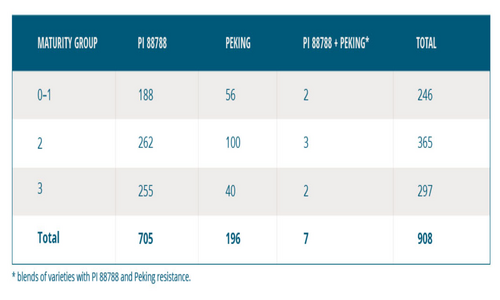| Number of SCN-resistant soybean varieties available for use in 2026 in Iowa. |
Source: The SCN Coalition news release
Waukesha, Wis. — The most effective way to actively manage soybean cyst nematode (SCN) is to rotate growing SCN-resistant soybean varieties with different resistance genetics. Because the seed industry doesn’t have a standard way to communicate which SCN resistance genes are in each variety, rotating varieties with different resistance genes isn’t as straightforward as it sounds.
To help Iowa farmers know what their options are, Greg Tylka, Morrill Professor and nematologist at Iowa State University, spearheads field experiments each year testing the yield and SCN control of resistant varieties around the state. The results of the testing are made possible by checkoff funding through the Iowa Soybean Association.
The variety testing effort is complemented by the annual release of a list of SCN-resistant soybean varieties available for Iowa — results farmers in states using similar relative maturities can also utilize.
For the 2026 growing season, Iowa farmers can choose from 908 SCN-resistant varieties, stemming from 35 brands and 25 seed companies. For the third consecutive year, soybean farmers have had over 900 options available.
SCN: A revenue robber
Why is SCN such a big deal? For one, it tops the list of yield-robbing pathogens for the North American soybean crop year after year.
It’s also a sneaky pathogen, costing farmers bushels with little to no visible aboveground symptoms. Using The SCN Coalition’s free SCN Profit Checker (no login needed), farmers can estimate just how much SCN is costing them in each of their fields. Spoiler: It’s more than many expect.
Powered by data from more than 35,000 university research plots, the SCN Profit Checker is a tool grounded in reality rather than hypotheticals. It’s easy to use and works best with an SCN soil test. Fall is a great time to collect soil samples.
Peking, PI 88788 or both?
Besides detailing the relative maturities of the resistant varieties, the list also specifies the genetic source of SCN resistance and a few other characteristics. That’s because one way to lower SCN populations and slow or prevent SCN from overcoming a single source of resistance is by rotating between Peking and PI 88788 resistance, which keeps nematodes on their toes.
Varieties in roughly 78% of this year’s list contain PI 88788 resistance, nearly 22% use Peking resistance, and a handful of varieties use a blend or physical mixture of two varieties with the two resistance modes.
While SCN’s increasing reproduction levels on PI 88788 may tempt some farmers to plant soybeans with more effective and often higher-yielding Peking resistance year after year, that could cause even greater problems over the long-haul.
“Peking is fast-acting and highly effective, so very few nematodes are able to overcome Peking resistance,” Tylka explains. “But those that do reproduce on plants with Peking resistance are likely to pass that ability on to their offspring.”
The impact is that exclusive use of Peking resistance could lead to even more SCN reproduction and fewer options for managing the parasitic roundworm in the not-so-distant future. Therefore, it’s important that a farmer’s management strategy includes rotating Peking SCN-resistant varieties with varieties containing PI 88788 in SCN-infested fields.
Rotate, rotate, rotate
This list is an incredible resource for farmers in Iowa and other areas of the Corn Belt for actively managing SCN, since so much of the strategy requires a farmer knowing what source of SCN resistance they are planting. Some key tenets of active management include the following:
· Start growing varieties with Peking SCN resistance NOW.
· Never grow varieties with Peking SCN resistance in consecutive soybean crops.
· Alternate growing Peking SCN-resistant varieties with varieties containing PI 88788 resistance.
· Plant non-host crops, such as corn, in annual rotation with soybeans.
While a silver bullet for wiping out SCN doesn’t exist (yet), strategically rotating resistance and nonhost crops such as corn can slow or possibly prevent populations of SCN from becoming resistant to the two modes of resistance. This list gives farmers the information they need to put that strategy to work and reclaim bushels. Learn more about active SCN management at TheSCNCoalition.com.





